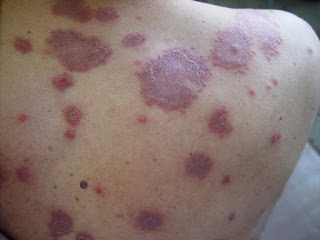Chloroma Pictures, Definition, Symptoms, Causes, Survival Rate, Treatment
Chloroma is a condition in which leukemic cells start accumulating around bone marrow. These leukemic cells are solid in nature. Basically it is a tumor of immature white blood cells. Chloroma is also known as extramedullary myeloid tumor and granulocytic sarcoma. The immature white blood cells responsible for tumor are called as myeloblasts. Extramedullary myeloid tumor has a tint of green color in it because of myeloid peroxidase. So due to this green color it is known as chloroma. Chloroma is basically derived from chloros meaning green color in Greek language. There is a link between acute leukemia and chloroma.
Chloroma is a rare disease. As it has a link with acute leukemia, so their symptoms resemble a lot. So common signs and symptoms involve

Chloroma occurs as a result of abnormal development of DNA in bone marrow cells. This abnormality let cells grow and divide when normal cells stop growing and dividing themselves and eventually die. This may lead to abnormal blood cells production. Bone marrow starts producing immature cells and these immature cells start converting into leukemic cells. As a result, these leukemic cells start accumulating around bone marrow causing chloroma. Scientists discovered that in most cases, it is not inherited from parents to their offsprings. Still the causative DNA mutations are not known which leads to extramedullary myeloid tumor I.e. chloroma.
Chloroma is considered a systemic disease rather than localized disease. Leukemic chemotherapy is recommended as a 1st line treatment. Chloroma shows response towards chemotherapy because it is quite sensitive towards standard anti leukemic therapy. Allogeneic hematopoietic stem cells are transplanted in patients with good health. If chloroma still persists after chemotherapy, then a localized treatment is preferred I.e. surgery or radiation therapy. These localized treatment processes do not have any impact on survival rate. Chemotherapy is mostly recommended for patients with primary chloroma. In case of relapsed leukemia, treatment outcomes are not good and satisfactory.
There isn't any proper data about success rates of treatment. It has been seen that scientists argue about poor prognosis and survival rate of chloroma. People show less response to chemotherapy and as a result condition becomes worse. So survival rate is down. It totally depends upon the stage of tumor. If patient is diagnosed with last stage chloroma or acute lymphocytic leukemia then survival chances are very low. Contrary to it, if chloroma is diagnosed at its initial stage, then patient will well respond to the chemotherapy and there will be greater chances of patient survival.
Chloroma Symptoms
Chloroma is a rare disease. As it has a link with acute leukemia, so their symptoms resemble a lot. So common signs and symptoms involve
- Severe and continuous nose bleeding.
- Blood flows out of nose frequently.
- As bone marrow is involved, so pain in joints and in bones is common symptom.
- Along with nose, bleeding may also occur via gums.
- Activation of immune system can cause fever.
- Lungs are also affected, as patient faces difficulty in breathing.
- Weakness and fatigue occurs.
- Skin may turn pale in color.
- Patient may feel lumps in armpits, groin area and around neck.

Chloroma Causes
Chloroma occurs as a result of abnormal development of DNA in bone marrow cells. This abnormality let cells grow and divide when normal cells stop growing and dividing themselves and eventually die. This may lead to abnormal blood cells production. Bone marrow starts producing immature cells and these immature cells start converting into leukemic cells. As a result, these leukemic cells start accumulating around bone marrow causing chloroma. Scientists discovered that in most cases, it is not inherited from parents to their offsprings. Still the causative DNA mutations are not known which leads to extramedullary myeloid tumor I.e. chloroma.
Chloroma Treatment
Chloroma is considered a systemic disease rather than localized disease. Leukemic chemotherapy is recommended as a 1st line treatment. Chloroma shows response towards chemotherapy because it is quite sensitive towards standard anti leukemic therapy. Allogeneic hematopoietic stem cells are transplanted in patients with good health. If chloroma still persists after chemotherapy, then a localized treatment is preferred I.e. surgery or radiation therapy. These localized treatment processes do not have any impact on survival rate. Chemotherapy is mostly recommended for patients with primary chloroma. In case of relapsed leukemia, treatment outcomes are not good and satisfactory.
Chloroma Survival Rate
There isn't any proper data about success rates of treatment. It has been seen that scientists argue about poor prognosis and survival rate of chloroma. People show less response to chemotherapy and as a result condition becomes worse. So survival rate is down. It totally depends upon the stage of tumor. If patient is diagnosed with last stage chloroma or acute lymphocytic leukemia then survival chances are very low. Contrary to it, if chloroma is diagnosed at its initial stage, then patient will well respond to the chemotherapy and there will be greater chances of patient survival.
Chloroma Pictures, Definition, Symptoms, Causes, Survival Rate, Treatment
 Reviewed by Simon Albert
on
March 17, 2019
Rating:
Reviewed by Simon Albert
on
March 17, 2019
Rating:
 Reviewed by Simon Albert
on
March 17, 2019
Rating:
Reviewed by Simon Albert
on
March 17, 2019
Rating:











